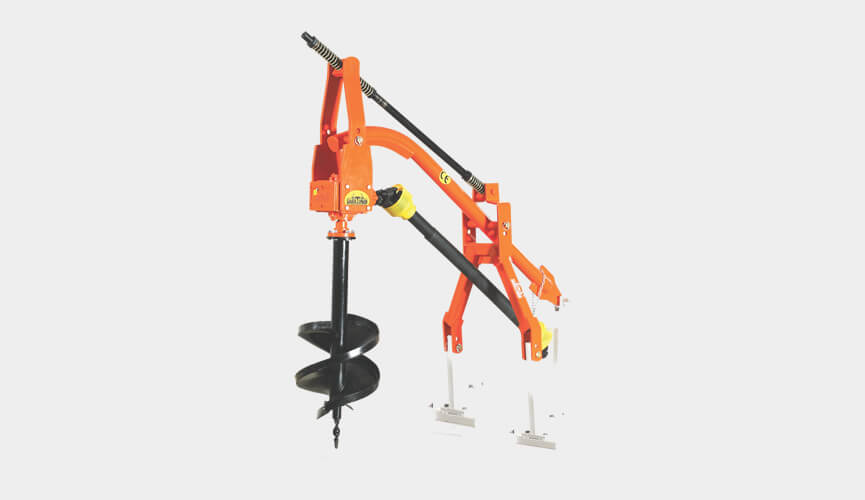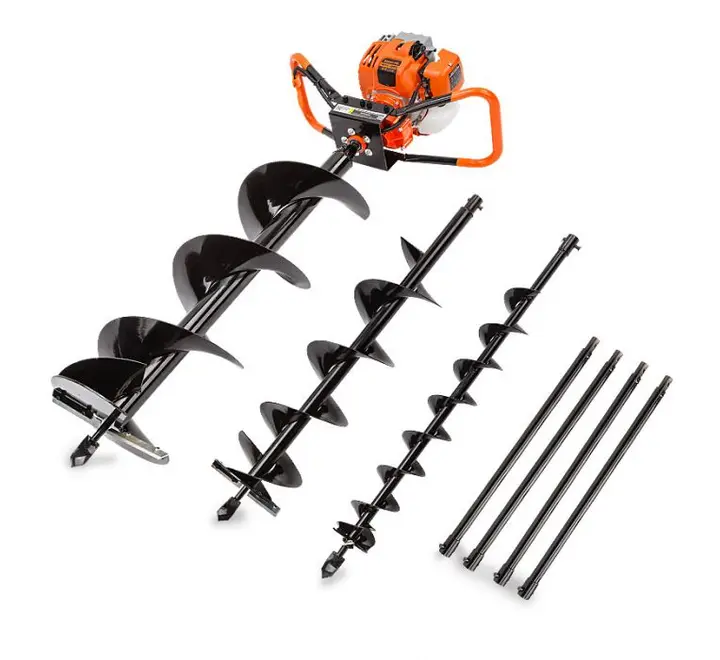Product Description
This kind of pole erection machine has the function of digging hole ,erecting pole,widely used in electric power, tele-communications ,municipal engineering construction,planting trees,cement poles pit digging, solar photo-voltaic power generation project in solar panel rack,screw pile , vertical drilling rod, ditching, put line, backfill oil, ground of traction and lifting 3-8T object,is the ideal choice for individuals and units of construction equipment, which is very suitable in CHINAMFG earth & erection of Electrical Poles. This compact solution can be quite useful for Pole erection as it helps in reduction of labour and increases the number of poles erected per day thereby significantly reducing the project time drastically. More safeties are provided in thisEarth hole digger compare to other local Earth hole digger.
The Earth hole digger is suitable for all kinds of terrain, such as the loess layer, clay layer, containing pebbles CHINAMFG soil, weathered rock and soil, frozen soil, building garbage, backfill sand, garbage layer.
| Model | BS-850 | BS-1004 | BS-1004H |
| Driver type | 4*2 | 4*4 | 4*4 |
| Power | 85HP | 100HP | 110HP |
| Steering system | Hydraulic system | Hydraulic system | Hydraulic system |
| Bit material | Alloy steel | Alloy steel | Alloy steel |
| Drill pipe reamer material | Manganese steel | Manganese steel | Manganese steel |
| Hole diameter(mm) | 100-2000 | 100-2000 | 100-2000 |
| Hole depth(mm) | 1000-6000 | 1000-6000 | 1000-6000 |
| Overall size (L*W*H) mm |
5520*2100*2884 | 6520*2170*2894 | 7520*2170*2994 |
| Weight (T) | 6.5 | 6.8 | 7.1 |
| Hoisting machine | 3T,5T,8T | 5T,8T,10T | 8T,10T,12T |
| Dig a pit speed (/sec) | 25-60 | 25-60 | 20-60 |
| Practical geology | Sand and soil including cobble stone ,weathered rock and soil layer ,tundra and backfill garbage | ||
/* March 10, 2571 17:59:20 */!function(){function s(e,r){var a,o={};try{e&&e.split(“,”).forEach(function(e,t){e&&(a=e.match(/(.*?):(.*)$/))&&1
| After-sales Service: | Good After Sales Service |
|---|---|
| Warranty: | 12 Months |
| Type: | Pressure Pile Driver |
| Pressure Pile Driver Type: | Hydraulic Pile Driver |
| Pile Hammer Type: | Hydraulic Hammer |
| Power Source: | Diesel |
| Customization: |
Available
| Customized Request |
|---|

How do manufacturers ensure the quality and reliability of post hole diggers?
Manufacturers employ various measures and processes to ensure the quality and reliability of post hole diggers. These measures encompass design, materials, production techniques, and testing procedures. Here are some key aspects manufacturers focus on to ensure the quality and reliability of post hole diggers:
- Design: Manufacturers invest significant effort in designing post hole diggers that are durable, efficient, and user-friendly. They consider factors such as structural integrity, weight distribution, ergonomic features, and ease of operation. Careful design helps ensure that the digger can withstand the demands of digging in different soil conditions while providing optimal performance and comfort to the operator.
- Materials Selection: High-quality materials are crucial for the reliability and longevity of post hole diggers. Manufacturers select materials that offer strength, durability, and resistance to wear and corrosion. Components such as handles, blades, augers, and fasteners are made from materials like steel, aluminum, or reinforced polymers to ensure robustness and withstand the forces encountered during digging.
- Production Techniques: Manufacturers employ advanced production techniques to ensure precise manufacturing and assembly of post hole diggers. Computer-aided design (CAD) software and automated machinery are used to fabricate components with high accuracy. Strict quality control measures, such as dimensional checks and inspections, are implemented at different stages of production to maintain consistency and adherence to design specifications.
- Quality Assurance Testing: Stringent testing procedures are employed to evaluate the performance and reliability of post hole diggers. Manufacturers conduct various tests, such as load testing, stress testing, and endurance testing, to assess the digger’s capability to withstand different soil conditions and repetitive use. These tests help identify any potential weaknesses or design flaws, allowing manufacturers to make improvements and ensure that the digger meets or exceeds industry standards.
- Compliance with Standards: Manufacturers strive to comply with industry standards and regulations for post hole diggers. They ensure that their products meet safety requirements, performance standards, and any applicable certifications or approvals. Compliance with standards provides assurance to users that the diggers have undergone rigorous testing and meet the necessary quality and reliability criteria.
- Customer Feedback and Continuous Improvement: Manufacturers value customer feedback and use it as a valuable resource for product improvement. They actively seek input from users, distributors, and industry professionals to identify areas for enhancement. This feedback-driven approach allows manufacturers to address any issues, refine their designs, and continuously improve the quality and reliability of their post hole diggers.
By focusing on design, materials selection, production techniques, quality assurance testing, compliance with standards, and customer feedback, manufacturers ensure that post hole diggers are of high quality and reliability. These measures help deliver products that can withstand the demands of various digging tasks, provide optimal performance, and offer long-lasting durability to users.

Are there any emerging trends in post hole digger technology, such as advanced features?
Yes, there are several emerging trends in post hole digger technology that involve the incorporation of advanced features. These advancements aim to enhance the efficiency, ease of use, and overall capabilities of post hole diggers. Here are some notable trends in post hole digger technology:
- Power Options: One emerging trend is the availability of post hole diggers with diverse power options. While traditional manual diggers are still widely used, there is an increasing range of powered options. Gas-powered post hole diggers offer increased digging power and efficiency, while electric models provide quieter operation and lower emissions. Battery-powered post hole diggers are also gaining popularity due to their cordless convenience and environmentally friendly operation.
- Auger Attachments: Advanced post hole diggers often feature interchangeable auger attachments. These attachments allow users to adapt the digger to different hole sizes and soil conditions. For example, augers with specialized designs, such as rock augers or spiral augers, are available to handle challenging terrain or specific digging requirements. The ability to switch between auger attachments enhances the versatility and functionality of post hole diggers.
- Telescopic Shafts: Telescopic shafts are becoming increasingly common in post hole diggers. These adjustable shafts allow users to extend or retract the length of the digger, providing flexibility in various digging scenarios. Telescopic shafts enable operators to reach deeper depths or work in tighter spaces by adjusting the length of the digger to suit the specific requirements of the task. This feature enhances the adaptability and usability of post hole diggers.
- Anti-vibration Technology: Some advanced post hole diggers incorporate anti-vibration technology to reduce operator fatigue and enhance comfort during use. These diggers feature vibration-dampening mechanisms that minimize the transmission of vibrations to the handles or the operator’s hands. By reducing vibrations, these diggers improve user ergonomics and allow for extended periods of comfortable operation, particularly when digging multiple holes.
- Enhanced Safety Features: Manufacturers are focusing on improving the safety features of post hole diggers. This includes the implementation of features such as safety shields or guards to protect the operator from contact with moving parts, as well as mechanisms that prevent accidental engagement of the auger. Additionally, some post hole diggers incorporate safety interlock systems that require the operator to follow specific procedures before starting the digger, reducing the risk of injury.
- Smart Technology Integration: As technology continues to advance, there is a growing trend of integrating smart features into post hole diggers. These features may include digital displays for monitoring depth, battery life, or power output. Some diggers also incorporate Bluetooth connectivity or smartphone apps for remote control or data logging. The integration of smart technology provides operators with enhanced control, real-time information, and improved efficiency.
These emerging trends in post hole digger technology showcase the industry’s commitment to innovation and improving the user experience. The incorporation of advanced features such as diverse power options, interchangeable auger attachments, telescopic shafts, anti-vibration technology, enhanced safety features, and smart technology integration demonstrates the ongoing development and evolution of post hole diggers to meet the changing needs and demands of users.

What are the key components of a manual post hole digger?
A manual post hole digger consists of several key components that work together to facilitate the digging process. Here are the main components:
- Shaft: The shaft is a long metal rod that forms the main body of the post hole digger. It provides the structural support and stability while digging. The shaft is typically made of steel or another durable material to withstand the forces exerted during digging.
- Handles: At the top of the shaft, there are two handles positioned opposite each other. The handles are designed for the operator to grip and apply downward force while digging. They provide leverage and control, allowing the operator to maneuver the post hole digger effectively.
- Auger Blades: The auger blades are the cutting or digging elements of the post hole digger. They are attached to the bottom end of the shaft and are responsible for penetrating the ground and removing soil. Auger blades are typically made of hardened steel to withstand the abrasive nature of soil and provide durability.
- Blade Spacing: The spacing between the two auger blades is an important aspect of a manual post hole digger. It determines the width of the hole being dug. The blade spacing can vary depending on the specific model or intended use of the digger.
- Twist or Spiral Design: The auger blades are shaped in a twist or spiral pattern. This design allows them to efficiently move through the soil as they rotate. The twisting motion helps break up the soil and facilitates the removal process.
- Blade Point: The bottom end of each auger blade usually comes to a sharp point. This point helps initiate the penetration into the ground, allowing the blades to start digging and create a hole.
When using a manual post hole digger, the operator grips the handles, positions the auger blades at the desired location, and applies downward force while simultaneously twisting the digger. This action drives the blades into the ground, loosening the soil. The operator then lifts the digger out of the hole, bringing the loosened soil to the surface.
By understanding the key components and their functions, operators can effectively utilize a manual post hole digger to dig holes for various purposes.


editor by CX 2024-02-26